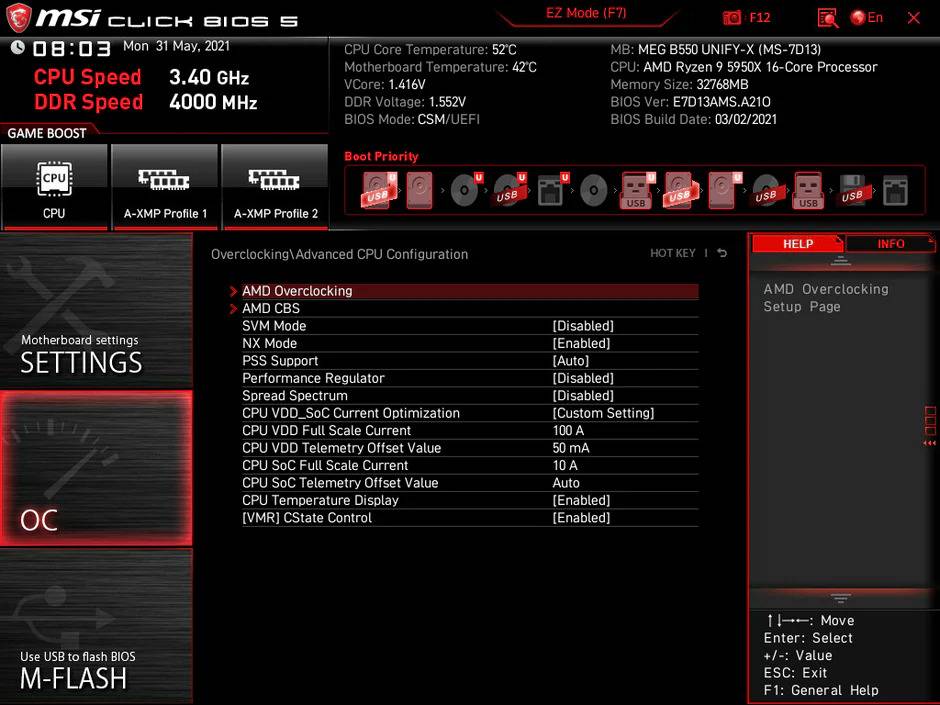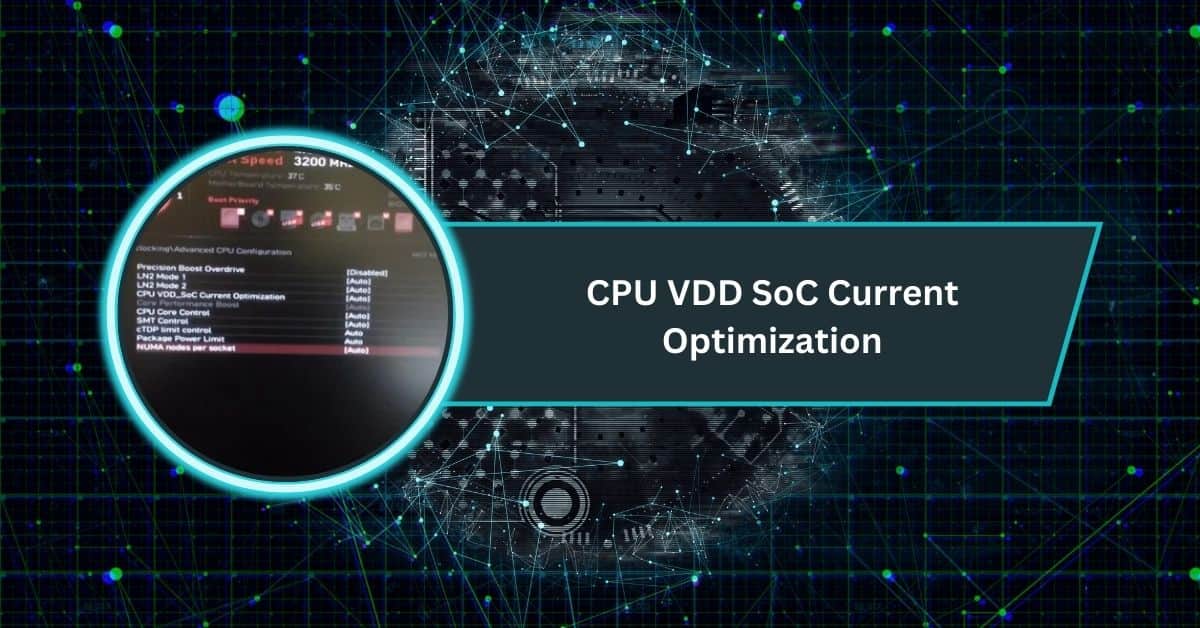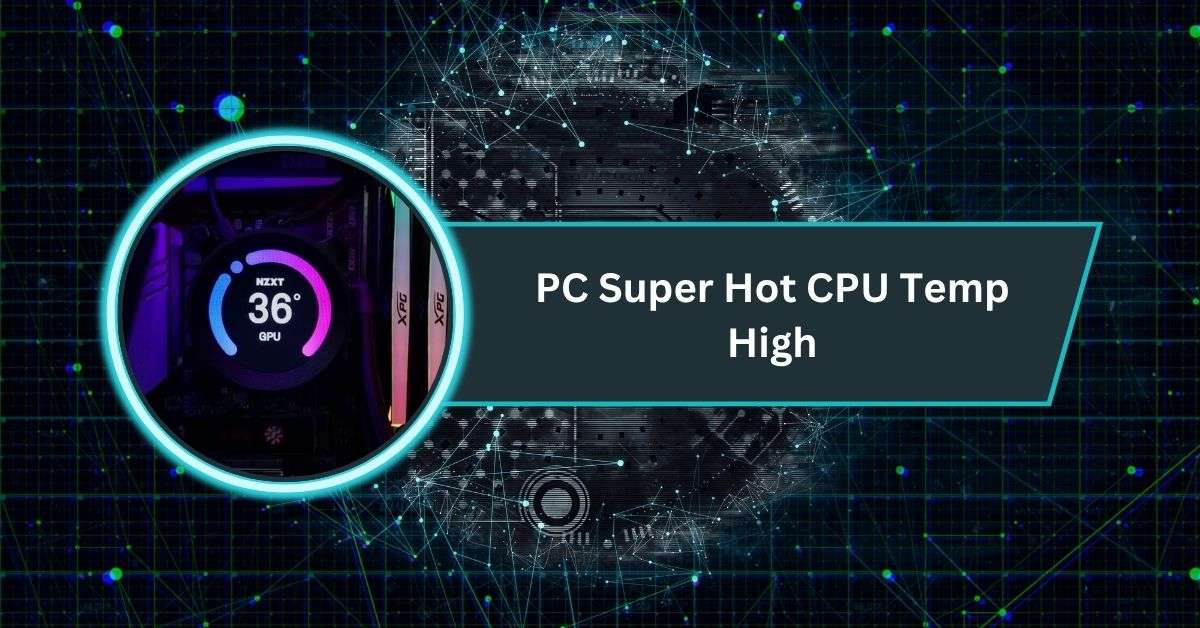Modern CPUs are more complex than ever. With multiple cores, integrated memory controllers, and advanced interconnects, they rely on carefully balanced power delivery to function at peak efficiency.
CPU VDD SoC Current Optimization manages voltage and current for CPU’s System-on-Chip, improving stability and telemetry accuracy. Safe tuning keeps CPU SoC voltage below 1.3V, ensuring efficient performance, reliable power delivery, and reduced errors during heavy workloads.
This article explains what CPU VDD SoC Current Optimization is, why it matters, what the latest community data says, and how you can adjust it safely.
Understanding CPU VDD SoC
To make sense of this setting, let’s break it down:
- VDD (Voltage Drain to Drain): This refers to the supply voltage that powers a specific circuit or domain within the CPU.
- CPU Core vs SoC: The CPU cores have their own voltage and current requirements. The SoC (System-on-Chip) domain powers essential integrated components like the memory controller, PCIe lanes, Infinity Fabric interconnect, and I/O interfaces.
Unlike the core voltage (Vcore), which is commonly adjusted during CPU overclocking, the SoC voltage (VSOC) ensures that memory, fabric, and interconnects run reliably. Optimizing current allocation here helps the SoC handle workloads efficiently without instability.
What is CPU VDD SoC Current Optimization?

In most AMD motherboards, particularly MSI, ASUS, and Gigabyte, you’ll find this BIOS option under advanced CPU power settings. CPU VDD SoC Current Optimization determines how the system manages the current supplied to the SoC domain.
The setting often appears alongside related parameters:
- CPU VDD Full Scale Current – Defines the maximum current limit for the CPU domain.
- CPU VDD Telemetry Offset – Adjusts reporting offset for CPU power draw.
- CPU SoC Full Scale Current – Similar limit but for the SoC domain.
- CPU SoC Telemetry Offset – Corrects telemetry readings for SoC power.
When set to Auto, the BIOS applies motherboard-specific defaults. When switched to Custom, you can define scaling limits yourself. These settings tie into Precision Boost Overdrive (PBO) and other boost algorithms, which rely on accurate current reporting.
Why Optimize? (Benefits and Risks)
Benefits
- Improved Stability Under Load
By aligning current limits with actual power delivery, you reduce false throttling or misreporting. This can eliminate random errors under stress. - Accurate Power Telemetry
Tools like HWInfo or Ryzen Master use telemetry data to report CPU package power. Without proper scaling, you might see deviations of 10–20%. Adjusting limits can bring them closer to reality. - Performance Gains
Correct optimization ensures that boost algorithms (like PBO) know the “true” current draw. In some cases, this allows sustained higher boost clocks without triggering power limits too early.
Risks
- Instability – Pushing current limits too far may result in WHEA errors, system crashes, or boot failures.
- Heat & VRM Stress – Higher current allowances increase VRM workload, potentially raising temperatures.
- Silicon Lottery – Every CPU behaves differently; a stable value on one chip may be unstable on another.
Factors Affecting CPU Vdd Soc Current Optimization
- CPU Architecture & Model – Different Ryzen/CPU generations have unique SoC power requirements.
- Motherboard VRM Quality – Strong VRMs handle higher current more efficiently.
- BIOS/UEFI Settings – Auto vs custom values for current limits and telemetry offsets.
- SoC Voltage (VSOC) – Keeping it ≤ 1.3V ensures stability and longevity.
- Precision Boost Overdrive (PBO) & Overclocking – Alters how current optimization impacts performance.
- Memory & Infinity Fabric Speed – Higher RAM and FCLK speeds demand more stable SoC power.
- Cooling System – Better CPU and VRM cooling prevents thermal throttling.
- Power Supply Quality – Stable PSU output supports consistent current delivery.
- Workload Type – Heavy multitasking, gaming, or rendering stress SoC differently.
- Firmware & Driver Updates – Vendor optimizations can change current scaling behavior.
Techniques for CPU Vdd Soc Current Optimization
1. Dynamic Voltage and Frequency Scaling (DVFS)
DVFS changes the CPU’s speed and voltage depending on workload. When tasks are light, it lowers power use; when heavy tasks arrive, it boosts speed. This smart adjustment saves energy while keeping performance smooth and reliable.
2. Power Gating
Power Gating works like turning off unused lights in your home. It shuts down idle CPU parts to save power and reduce heat. When needed again, those parts quickly wake up, keeping the system efficient and fast.
3. Adaptive Voltage Scaling (AVS)
AVS adjusts voltage in real time based on actual CPU needs. Instead of using fixed voltage, it gives just enough power. This prevents waste, improves battery life in laptops, and reduces stress on desktop processors.
Latest Data & Community Findings (2024–2025)
Since AMD does not publish exhaustive documentation on these parameters, much of the practical data comes from enthusiasts experimenting with them. Here are some findings:
- Ryzen PBO Test – Full Scale Current at 220A
A user reported stable performance with CPU VDD Full Scale Current ~220A and telemetry offset ~30 mV. Going higher degraded stability and thermals. - MSI B450 Example – Correcting PRD
Another user noticed Power Reporting Deviation (PRD) was showing 114–125% under load, suggesting inaccurate readings. By adjusting CPU VDD Full Scale Current to 145A, PRD aligned closer to 100%, meaning the CPU’s power draw was measured correctly. - Safe SoC Voltage Levels
Overclocking communities generally recommend keeping VSOC ≤ 1.30 V. Exceeding this increases risk of long-term degradation. For daily use, many stay around 1.10–1.20 V. - Stability & WHEA Errors
Several reports suggest that tuning SoC current optimization can reduce WHEA Logger Event 19 errors, which often appear when memory and interconnects are unstable. - Auto vs Manual
On many modern boards, Auto performs well enough for most users. Enthusiasts switch to Custom mainly when fine-tuning for benchmarking or squeezing extra MHz from memory overclocks.
Technical Insights from Research
Academic and industry research also sheds light on why this tuning matters.
- Dynamic Voltage and Frequency Scaling (DVFS): This technique dynamically adjusts voltage and frequency across CPU and SoC domains. Accurate current limits ensure DVFS algorithms allocate power efficiently.
- SysScale (2020): A study on multi-domain power orchestration showed that dynamically shifting power budgets between CPU cores, memory, and I/O domains can significantly improve efficiency. This is essentially what “SoC Current Optimization” is about – balancing limited power across competing demands.
- SoC-Level Power Design in 2025: With CPUs becoming more integrated, domain-level optimization is increasingly critical. Mobile SoCs and desktop APUs use these strategies to extend battery life or maximize performance under thermal envelopes.
How to Safely Tweak CPU VDD SoC Current
If you want to experiment, follow these steps carefully:
- Start with Auto
Ensure your system is stable at default settings before making changes. - Increment Gradually
For CPU VDD Full Scale Current, move in small steps (e.g., 120A → 130A → 145A). - Monitor Telemetry
Use HWInfo64 to check Power Reporting Deviation (PRD) and current draw. Aim for PRD close to 100%. - Stress Test
Run Cinebench R23, Prime95, or OCCT. Watch for WHEA errors in Event Viewer. - Watch Temperatures
VRM temps should stay well below 90°C under load. CPU package temps ideally < 85°C. - Have a Fallback Plan
If your system becomes unstable, reset BIOS via jumper or clear CMOS button.
Best Practices & Recommendations
- Stay Below 1.30 V VSOC – Safer for long-term use.
- Avoid Extreme Settings for Daily Use – Reserve high limits for benchmarking sessions.
- Prioritize Cooling & VRM Quality – Stable current delivery requires strong hardware support.
- Update BIOS Regularly – Motherboard vendors refine these algorithms with firmware updates.
- Document Your Changes – Keep track of what values you tested for future reference.
FAQs
What is CPU VDD full scale current?
It’s the maximum current your CPU can safely draw. Setting it correctly ensures accurate power readings, stability, and avoids unnecessary throttling issues.
What is the VDD of a CPU?
VDD is the supply voltage that powers the CPU’s circuits. It keeps everything running, from cores to controllers, ensuring reliable and efficient operation.
What is a good voltage for a Vddcr CPU?
A good VDDCR CPU voltage is usually between 1.1V and 1.3V. Staying in this range balances performance, safety, and processor longevity effectively.
What is CPU Vddcr?
CPU VDDCR is the main regulated voltage supply for processor cores. It directly impacts performance, power use, and overall system stability during workloads.
Should I enable global C state control?
Yes, enabling Global C-State Control is recommended. It allows your CPU to save power during idle times, without affecting performance in daily tasks.
What should I change my CPU voltage to?
Always start with Auto. For manual settings, keep CPU core voltage between 1.2V–1.3V. This range is safe and stable for most systems.
What is the proper CPU voltage?
The proper CPU voltage depends on your model. Typically, 1.2V to 1.3V works best, balancing reliable performance while preventing overheating and hardware stress.
What is SVI3?
SVI3 is AMD’s scalable voltage interface. It allows precise communication between CPU and VRMs, ensuring efficient power delivery, monitoring, and better voltage regulation.
What is CPU VDD 1.8 voltage?
CPU VDD 1.8 voltage powers specific CPU functions like PLLs and certain I/O logic. It usually runs at 1.8V to maintain stability.
What should DRAM VDD voltage be?
Most DDR4 RAM runs best at 1.2V, while overclocked modules may need 1.35V. Always check your RAM specifications for proper, stable voltage settings.
Conclusion
CPU VDD SoC Current Optimization may sound technical, but it plays a big role in keeping modern processors both fast and stable. By carefully managing the voltage and current supplied to the SoC domain, you help your CPU deliver reliable performance without unnecessary heat or errors.
For most users, leaving the setting on Auto is safe and effective. Enthusiasts, however, can experiment with custom tuning to fine-tune telemetry accuracy, reduce WHEA errors, or push for extra stability when overclocking. The key is to make small changes, monitor results, and always stay within safe ranges—especially keeping VSOC under 1.30V.
In the end, optimizing SoC current is about balance. With proper settings, strong cooling, and attention to safe limits, you can unlock smoother performance, longer hardware life, and a more efficient system overall.











